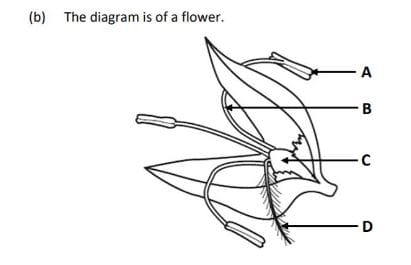
Use the diagram to answer question 1 to 10
- Knowledge (Remembering):
What structure is labeled ‘A’ in the diagram?
a) Sepal
b) Anther
c) Stamen
d) Pistil - Comprehension (Understanding):
Which part of the flower labeled in the diagram is typically the most colorful and attractive to pollinators?
a) A
b) B
c) C
d) It is not labeled - Application (Applying):
If structure C were removed, what process would be directly affected?
a) Photosynthesis
b) Pollination
c) Fertilization
d) Seed dispersal - Analysis (Analyzing):
How does the position of structure D relate to its function in the flower?
a) Its central location protects it from damage
b) Its position allows easy access for pollination
c) It supports the weight of the other structures
d) Its location optimizes sunlight absorption - Evaluation (Evaluating):
Which statement best evaluates the importance of structure B in relation to the flower’s survival?
a) It’s crucial for attracting pollinators
b) It’s the primary site of photosynthesis
c) It provides structural support for the flower anther
d) It’s essential for seed production - Synthesis (Creating):
If you were to design a flower to attract a specific nocturnal pollinator, which modification to the petals would be most effective?
a) Increase its size
b) Change its color to bright red
c) Make it release a strong fragrance at night
d) Remove it entirely - Knowledge (Remembering):
What is the collective term for all the structures for the petals in a flower?
a) Corolla
b) Calyx
c) Androecium
d) Gynoecium - Application (Applying):
In some flowers, the petals are fused. How might this affect the flower’s interaction with pollinators?
a) It would prevent pollination entirely
b) It could make nectar harder to access
c) It would have no effect on pollination
d) It would attract more diverse pollinators - Analysis (Analyzing):
Based on the diagram, which structure would you expect to find pollen?
a) A
b) B
c) C
d) D - Evaluation (Evaluating):
Which statement best assesses the overall design of this flower in terms of its reproductive strategy?
a) It’s designed for wind pollination
b) It’s optimized for self-pollination
c) It’s well-suited for animal pollination
d) It’s adapted for water-based pollination
These questions cover various levels of cognitive complexity, from simple identification to more complex analysis and evaluation of the flower’s structures and functions.
Here are the answers to the 10 multiple-choice questions:
- ) Anther
- ) It is not labeled
- ) Fertilization
- ) Its position allows easy access for pollinators
- ) It’s crucial for attracting pollinators
- ) Make it release a strong fragrance at night
- ) Calyx
- ) It could make nectar harder to access
- ) A
- ) It’s designed for wind pollination

